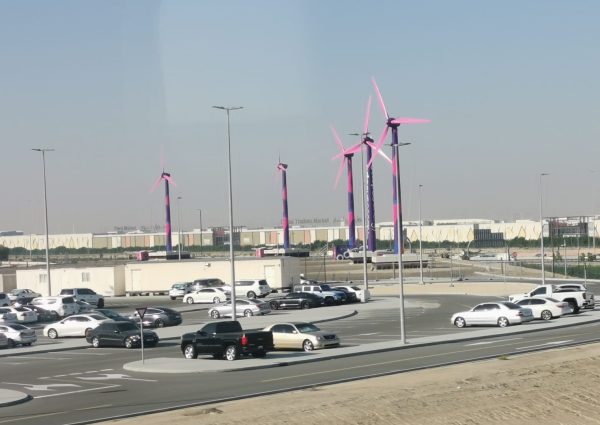
2023.12.01 Image credit-Emmanuel Essah- Pink wind turbines in Dubai.
Written by Fiona Spuler; SCENARIO DTP student
Reflections on the first few days of COP28, held this year in Dubai in the United Arab Emirates.
Dubai is home to the world’s largest gas-fired power station (as it is to the world’s tallest building, the world’s largest shopping mall and the world’s largest aqua park). It makes for quite an impressive sight that COP delegates pass by every morning, stretching over more than 3km along the metro line to the conference centre. With an installed capacity of 8.6 GW, it provides most of Dubai’s electricity, as well as the power for a neighbouring desalination plant (also the largest in the world). A few metro stations further along, the most astonishing site comes our way: four wind turbines, painted in bright pink and quite small in size. Built in only eight weeks by Octopus Energy, a British renewable energy company, they are meant to showcase the speed at which renewable technologies can be deployed, according to their CEO.
This daily metro ride somewhat illustrates the tensions and contrasts that have surrounded this year’s COP hosted by the United Arab Emirates (UAE) in Dubai. The wealth of the UAE stems entirely from the discovery of huge oil reserves in the 1960s which turbo-charged Dubai’s population growth and development from a small fishing village in the 19th century to a city now known for its superlatives. Even though climate conferences have been held in fossil fuel reliant countries before (think Katowice in Poland in 2018), this is the first time that the entire infrastructure the climate conference inhabits showcases the wealth that fossil fuels have brought to some people in some countries.
From 300 US and EU lawmakers signing a petition to remove the president of this year’s COP, Sultan Al Jaber, to a BBC investigation into discussions on fossil fuel deals that were planned at the conference, there has been well-founded doubt in this year’s COP presidency’s willingness to push for a fast phase out of fossil fuels. And the agenda and progress so far have not been able to prove sceptics wrong: while finance pledges that sum up to USD 57 billion for renewables, adaptation and loss and damage and an oil and gas decarbonization charter have been declared – all of which are good things – there is so far not a lot of hard evidence that the accelerated phase-out of fossil fuels required to reach the 1.5°C target is in this year’s COP president, priorities.
It is therefore easy to lose hope in the UNFCCC process of countries coming together at these climate conferences. The COP process is far from perfect and participation, particularly from especially vulnerable countries and indigenous communities, needs to be greatly improved. And of course, there are massive power disparities. Even outside the negotiation room, the indigenous peoples’ pavilion is placed a couple of meters away from the OPEC stand.
But these climate conferences are currently the only forum where a president of a small Pacific Island nation under threat from sea level rise speaks with and alongside the presidents of petrostates and powerful G7 countries. About how to transition our fossil fuel energy systems, who should pay for it, how to adapt to a climate that is already changing and compensation for the losses and damages. And there are many open issues on all of these crucial questions.
Hosting a COP in a petrostate such as the UAE can risk progress on this crucial issue by placing the agenda setting power of the conference of a presidency with strong vested interests. But we can also acknowledge that it offers us the opportunity to place increased scrutiny on the transition plans and commitments of countries like the UAE who still hope to generate further monetary wealth by exploiting further fossil fuel reserves. The COP presidency’s understanding of what it really means to aim for 1.5°C is now under increased scrutiny which is absolutely necessary.
In the metro on our way back, the incredible wealth that fossil fuels have brought to the UAE, the economic inequality and the racial discrimination that shapes the lives of the people living here are glaringly obvious and open on display. But these injustices are the more visible cousins of those same problems we see both in the UK and around the world. The industrialisation of the UK, for example, was fossil fuel driven, and it has now committed to giving out hundreds of new oil and gas drilling licenses in the North Sea.
So perhaps it is not so bad that we find ourselves passing by the world’s largest gas power station every day. Let’s just not get distracted by empty words and the world’s smallest and pinkest wind turbines. Rather, let us make use of this conference to push for a rapid and definitive closing date of the world’s largest gas power station.

